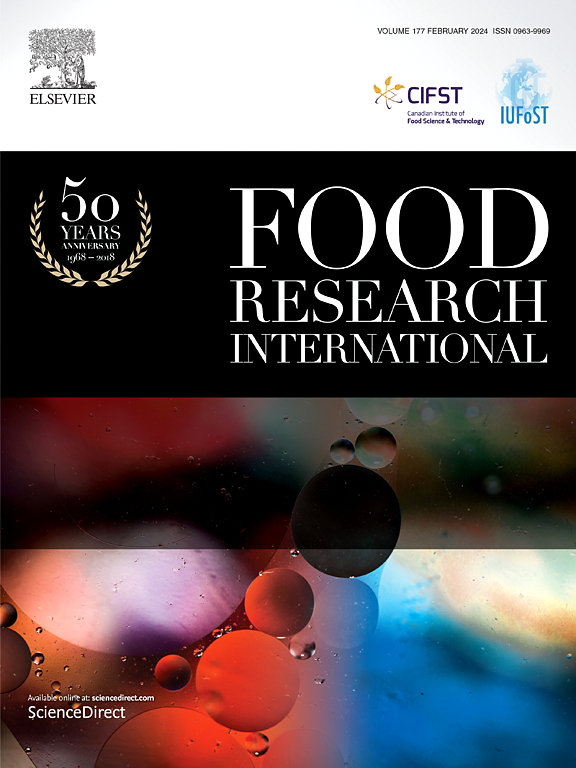葡萄茶(Ampelopsis grossedentata)通过YTHDF2/PGC-1α/SIRT3轴改善慢性酒精诱导的肝脏脂肪变性、氧化应激和炎症
IF 7
1区 农林科学
Q1 FOOD SCIENCE & TECHNOLOGY
引用次数: 0
摘要
一千多年来,蛇耳opsis grossedentata (Hand.-Mazz.)w.t.w Wang,俗称藤茶,作为一种受欢迎的茶和传统草药,具有抗氧化、抗炎、保护肝脏和抗病毒的特性。近年来,与酒精有关的肝损伤发病率呈上升趋势,给全世界造成了重大的公共卫生负担。先前的研究表明,藤茶提取物(AGE)可以改善酒精性肝病(ALD),但这种作用的药理学机制尚不清楚。在本研究中,我们首先采用UPLC-Q-TOF-MS分析了AGE的化学成分。随后,以Lieber-DeCarli日粮喂养小鼠建立ALD模型,通过测定生化指标和肝脏病理变化来评估AGE对肝脏的保护作用。此外,利用转录组学、加权基因共表达网络分析和单细胞数据挖掘等一系列生物信息学工具揭示了YTHDF2/PGC-1α/SIRT3信号轴可能是AGE发挥其抗ald作用的潜在机制。此外,Western blotting和免疫荧光染色技术进一步证实了上述机制。我们的研究结果表明,藤茶可以显著减轻慢性乙醇诱导的肝脏脂质积累、氧化应激和炎症。值得注意的是,敲低YTHDF2可以部分保护肝脏免受乙醇诱导的损伤。机制上,生物信息学分析和体内外实验证实YTHDF2是AGE治疗ALD的关键药理靶点,通过下游PGC-1α/SIRT3途径起作用。综上所述,在本研究中,我们首次提供了AGE通过抑制YTHDF2和增强PGC-1α和SIRT3表达来减轻乙醇诱导的肝损伤的证据。藤茶作为一种具有独特药用价值的茶类食品,在治疗ALD方面显示出显著的潜力和价值。本文章由计算机程序翻译,如有差异,请以英文原文为准。

Vine tea (Ampelopsis grossedentata) ameliorates chronic alcohol-induced hepatic steatosis, oxidative stress, and inflammation via YTHDF2/PGC-1α/SIRT3 axis
For over a millennium, the leaves of Ampelopsis grossedentata (Hand.-Mazz.) W. T. Wang, commonly known as vine tea, have been revered as a popular tea and traditional herbal remedy, possessing antioxidant, anti-inflammatory, hepatoprotective, and antiviral properties. In recent years, the incidence of alcohol-related liver injury has been on the rise, imposing a significant public health burden worldwide. Previous studies have indicated that extracts of vine tea (AGE) can ameliorate alcoholic liver disease (ALD), yet the pharmacological mechanisms underlying this effect remain poorly understood. In this study, we first employed UPLC-Q-TOF-MS to analyze the chemical constituents of AGE. Subsequently, an ALD model was established in mice fed with Lieber-DeCarli diet, and the hepatoprotective benefits of AGE were assessed by measuring biochemical indicators and hepatic pathological changes. Moreover, a suite of bioinformatics tools, including transcriptomics, weighted gene co-expression network analysis, and single-cell data mining, were utilized to reveal that the YTHDF2/PGC-1α/SIRT3 signaling axis may be the potential mechanism by which AGE exerts its anti-ALD effects. Additionally, Western blotting and immunofluorescence staining techniques were employed to further substantiate the aforementioned mechanism. Our findings demonstrate that administration of vine tea significantly alleviated chronic ethanol-induced hepatic lipid accumulation, oxidative stress, and inflammation. Notably, knockdown of YTHDF2 partially protected the liver from ethanol-induced injury. Mechanistically, bioinformatics analysis and in vitro and in vivo experiments identified YTHDF2 as a key pharmacological target of AGE in treating ALD, acting through the downstream PGC-1α/SIRT3 pathway. In summary, in this study, we provide the first evidence that AGE mitigates ethanol-induced liver injury by inhibiting YTHDF2 and enhancing the expression of PGC-1α and SIRT3. Vine tea, as a tea food with unique medicinal value, shows significant potential and value in the treatment of ALD.
求助全文
通过发布文献求助,成功后即可免费获取论文全文。
去求助
来源期刊

Food Research International
工程技术-食品科技
CiteScore
12.50
自引率
7.40%
发文量
1183
审稿时长
79 days
期刊介绍:
Food Research International serves as a rapid dissemination platform for significant and impactful research in food science, technology, engineering, and nutrition. The journal focuses on publishing novel, high-quality, and high-impact review papers, original research papers, and letters to the editors across various disciplines in the science and technology of food. Additionally, it follows a policy of publishing special issues on topical and emergent subjects in food research or related areas. Selected, peer-reviewed papers from scientific meetings, workshops, and conferences on the science, technology, and engineering of foods are also featured in special issues.
 求助内容:
求助内容: 应助结果提醒方式:
应助结果提醒方式:


